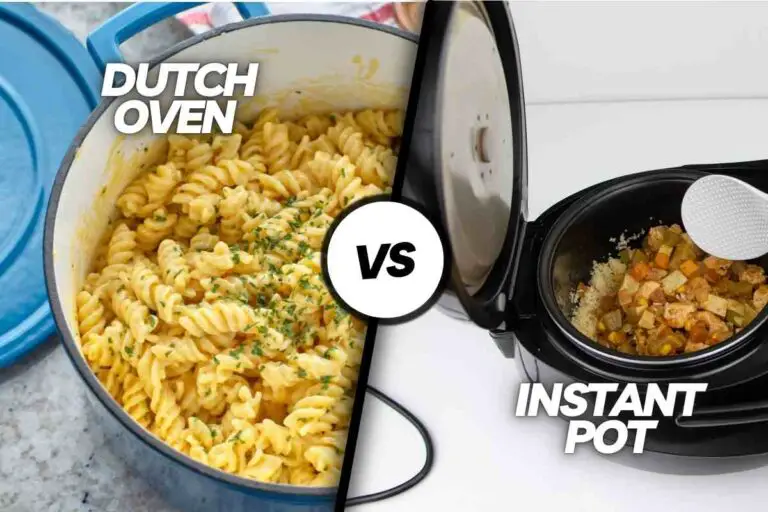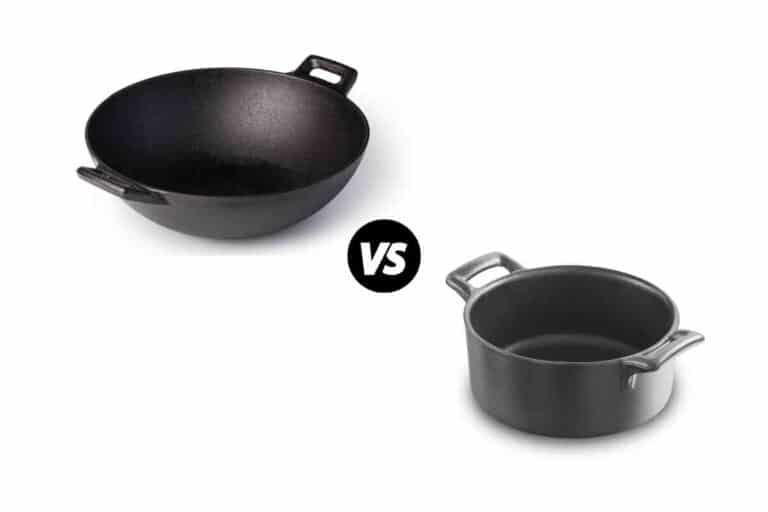13 Key Differences: Dutch Oven Vs Roasting Pan
The main difference between a Dutch Oven and a Roasting Pan lies in their design and intended use. A Dutch Oven is round with high sides, while a Roasting Pan is flat with low sides and is usually larger.
Dutch ovens can work as roasting pans when their lids are removed, whereas roasting pans with low sides and no lids cannot function as Dutch ovens.
Roasting pans excel at producing browner and crisper results, while Dutch ovens offer versatility and can perform all the functions of a roasting pan. Both can be used on stovetops and in ovens, making the choice between them dependent on specific cooking needs and preferences.
Each has its unique features and uses, and understanding the differences between them is key to making the best choice for your kitchen.
13 Factors: Dutch Oven Vs Roasting Pan
| Factor | Dutch Oven | Roasting Pan |
|---|---|---|
| Shape | Large, oval-shaped pot with high sides and tight-fitting lid. | Flat, rectangular pan with low sides, often with a roasting rack. |
| Materials | Cast iron or ceramic. | Aluminum or stainless steel. |
| Versatility | Versatile for various dishes, including stews, soups, baking, and more. | Specialized for roasting meats, limited versatility. |
| Moisture Retention | Excellent moisture retention for juicy dishes. | Limited moisture retention, liquids evaporate quickly. |
| Cooking Methods | Suitable for stovetop, oven, or open fire. | Primarily for oven use. |
| Weight | Heavy, especially cast iron versions. | Lighter and easier to handle. |
| Cost | Quality models can be expensive. | Generally more affordable. |
| Size Options | Available in various capacities. | Come in different sizes for different meat cuts. |
| Material Compatibility | Versatile with various stove types. | Compatible with most stovetops. |
| Primary Use | Can be used as a makeshift roasting pan with adjustments. | Ideal for roasting meats, crispy results. |
| Adaptability for Roasting | Can be adapted for roasting by removing the lid. | Specialized for roasting, no adaptations needed. |
| Versatility Beyond Roasting | Highly versatile for various dishes. | Limited adaptability for other cooking methods. |
| Alternatives and Adaptations | Can use as a makeshift roasting pan with adjustments. | Disposable aluminum bakeware or adaptations may be needed. |

Dutch Oven Overview
The Dutch oven is a versatile kitchen workhorse. It typically features a large, oval-shaped pot with high sides and a tight-fitting lid.
Dutch ovens are primarily made from two materials: cast iron and ceramic. Cast iron Dutch ovens are known for their excellent heat retention and even cooking, while ceramic options offer a more stylish and colorful alternative.
Advantages of Dutch Oven
- Versatility in Cooking: Dutch ovens can do it all. They’re perfect for simmering hearty stews, crafting mouthwatering soups, baking delicious bread, and even slow-cooking dishes. The high sides and tight lid help retain moisture, ensuring tender and flavorful results.
- Moisture Retention: Thanks to their design, Dutch ovens are masters at retaining moisture. This makes them ideal for recipes that require long, slow cooking, keeping your dishes juicy and succulent.
- Cooking Methods: Dutch ovens are incredibly versatile, working equally well on the stovetop, in the oven, or even over an open fire. This adaptability makes them a must-have in any kitchen.
Disadvantages of Dutch Oven
- Heavy and Bulky: Dutch ovens can be quite heavy, especially the cast iron ones. Moving them around the kitchen or storing them can be a bit of a workout.
- Cost Considerations: Quality Dutch ovens, especially enameled cast iron versions from brands like Le Creuset, can be pricey. However, they are often considered an investment in your kitchen.
Roasting Pan Overview
Roasting pans, on the other hand, are specifically designed for roasting meats. They have a flat, rectangular shape with low sides and often come with a roasting rack. These pans are typically made from aluminum or stainless steel.
Advantages of Roasting Pan
- Ideal for Roasting Meats: Roasting pans excel at their primary job – roasting. They provide an even cooking surface, allowing for crispy skin and perfectly cooked meats.
- Even Cooking and Crispy Results: The design of roasting pans ensures that heat is distributed evenly, promoting consistent cooking results.
Disadvantages of Roasting Pan
- Limited Versatility: Roasting pans are specialized cookware, primarily used for roasting meats. Their low sides and flat shape make them less suitable for other cooking methods.
- Liquids Evaporate Quickly: Due to their design, liquids can evaporate relatively quickly in roasting pans, which may require more attention during cooking.
Dutch Oven Vs. Roasting Pan: Main Differences
To summarize, the main differences between Dutch ovens vs roasting pans lie in their design and versatility. Dutch ovens are all-rounders, capable of tackling a wide range of recipes while roasting pans are tailored specifically for roasting meats.
Considerations for Choosing
When deciding between a Dutch oven and a roasting pan, several factors should influence your choice:
- Size and Capacity: Consider the size of your family and the quantity of food you typically prepare. Dutch ovens come in various capacities while roasting pans can accommodate different meat sizes.
- Material Compatibility: Ensure that the cookware you choose is compatible with your stove. Dutch ovens are usually versatile in this regard.
- Cooking Needs and Preferences: Think about your cooking style and preferences. Do you enjoy slow-cooked dishes, or do you frequently roast meats? Your specific cooking needs should guide your decision.
Using a Dutch Oven for Roasting
If you already own a Dutch oven and wish to roast, you can adapt it for this purpose. Simply remove the lid to allow for roasting. However, keep in mind that some adjustments, such as using a roasting rack or browning meat separately, may be necessary for optimal results.
Using Roasting Pan for Other Dishes
While roasting pans are primarily designed for roasting, you can still use them for baking or cooking other dishes. However, their limitations in terms of versatility should be considered.
Alternatives and Adaptations
If neither a Dutch oven nor a roasting pan seems like the perfect fit for your kitchen, there are alternatives and adaptations to consider:
- Disposable Aluminum Bakeware: If you roast infrequently and want easy cleanup, disposable aluminum bakeware can be a convenient choice.
- Adapting Existing Cookware: You can adapt existing pots and pans by using a roasting rack to elevate the roast, effectively turning them into makeshift roasting pans.
Is a Roasting Pan the Same as a Dutch Oven?
No, a roasting pan and a Dutch oven are not the same. A roasting pan is a large, rectangular metal pan with a rack used for roasting meats and poultry.
A Dutch oven is a heavy pot with a tight-fitting lid, made of cast iron or enamel-coated cast iron, used for slow cooking and baking.
Both can be used for similar purposes, but they differ in shape, material, and lid design.
Can You Use a Dutch Oven as a Roasting Pan?
A Dutch oven can be used as a roasting pan. Its heavy construction and tight-fitting lid make it suitable for slow roasting and braising meats and poultry, similar to a roasting pan.
The lid can be used to trap moisture and heat, resulting in a flavorful and tender roast. However, it is important to note that Dutch ovens come in different sizes and capacities, so they may not be suitable for large roasting jobs.
Conclusion
To sum up, understanding the difference between a roasting pan and a Dutch oven is crucial for making informed decisions in the kitchen.
If you already own a Dutch oven and don’t roast often, a dedicated roasting pan may not be necessary. However, for those who frequently prepare roasts, having both cookware options can be advantageous.
The choice ultimately comes down to your cooking style, preferences, and the versatility you seek in your kitchen.
Frequently Asked Questions (FAQs)
How Do I Choose the Right Roasting Pan or Dutch Oven?
Choosing the right cookware depends on factors like size, material, and your specific cooking needs. Consider the information provided in this article to make an informed decision.
Can I Use a Dutch Oven for Roasting?
Yes, you can use a Dutch oven for roasting by removing the lid. However, some adjustments may be necessary.
Are There Budget-Friendly Alternatives?
Yes, disposable aluminum bakeware and adapting existing cookware are cost-effective alternatives.






